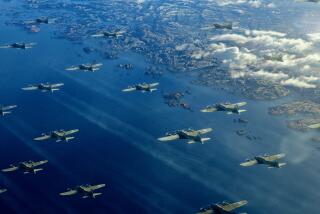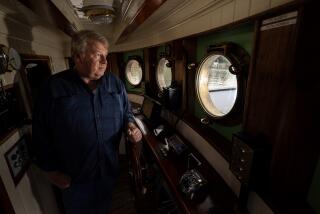Tom Matus Sees a Different Side of the Southland Thanks to His Seat at the Controls of the . . . : Blimp
Tom Matus has a different perspective on things.
While millions of other Americans watch such events as the Rose Parade and the Rose Bowl game on television or from seats in the grandstands, Matus gazes on them from above.
He pilots the Eagle, one of the three Goodyear blimps that have become familiar sights across the nation.
The Eagle, based in Carson, spends much of its time lumbering up and down the West Coast, providing aerial coverage of parades, bowl games, auto races, golf tournaments, yacht races, baseball games, tennis tournaments, professional football games and the like.
In other years, her sister ships--the Stars and Stripes, based in Florida, and the Spirit of Akron, based in Ohio--have often covered the Super Bowl. This year, with the game being played Sunday in Pasadena, the Eagle gets the job.
The Goodyear pilots used to be an unheralded bunch, operating the airshipsâ controls in silent anonymity while camera operators covered the action below. These days, TV directors usually include a brief shot of the cockpit interior.
âIt gives us a chance to wave at our girlfriends,â Matus said.
Pasadena is close by, but some of the events require considerable travel, which can be difficult for a cumbersome, 247,000-cubic-foot, helium-filled balloon.
Although the Eagle is powered by two 210-horsepower engines, it cruises at only about 30 m.p.h. If there are any head winds, the going can be even slower.
âSometimes it can get pretty boring,â Matus said. âBetween Palm Springs and Phoenix, thereâs nothing but sand for 300 miles. The only way to tell how fast youâre getting there is to watch your shadow moving along the ground. As they say, âThe Shadow knowsâ. . . .
âBecause there usually are winds, youâre often late for dinner,â he added. âOne thing Iâve learned: Never tell anyone when youâre going to get there.â
A support team follows the airship along the ground. If the weather gets bad or the winds get too strong, the team can set up a mooring pole in a few minutes, providing the Eagle with a safe place to land.
In between the events and the trips to and fro, Matus and his fellow Eagle pilots fly shorter missions. On clear nights, they cruise over the Los Angeles Basin, flashing public service and advertising messages with the 3,780 light bulbs on each side of the airship. On nice days, they take Goodyear guests up for brief joy rides.
Despite the Eagleâs 192-foot length and 50-foot girth, its cabin is only about the size of a minivan, capable of accommodating seven people--including the pilot.
Matusâ passengers for a recent sightseeing flight over the South Bay area included Jim Schell, a 56-year-old surgeon from Huntington Beach; Schellâs wife, Robin; their 15-year-old son, Tony; a reporter, and a photographer.
Matus related the history of Goodyearâs blimps, explaining that they date to 1925, when the company built its first in what was to become one of the most successful--and longest running--public relations stunts of all time.
But the military looked upon blimps as more than stunts. During World War II, the Navy used dozens of the airships as surveillance aircraft to watch for enemy submarines along the Pacific and Atlantic coasts.
Since then, Goodyearâs blimps have reverted to the PR business, being joined in recent years by rivals advertising film, beer, soda pop and life insurance, among other things.
How the non-rigid airships came to be called âblimpsâ is the subject of speculation, according to the tire company. A Goodyear pamphlet says the most plausible explanation involves a British aviator, Lt. A.D. Cunningham, commander of an air station at Capel, England, during World War I.
According to legend, Cunningham flipped his thumb against the taut fabric of one of the early airships, which resounded with an audible âblimp!â Or something like that.
Matus, a jovial, 54-year-old bachelor, told his passengers that he had been flying conventional, winged aircraft for a number of years when he heard that Goodyear needed a pilot.
âIt turned out they had a blimp instead of an airplane, and they were willing to teach me how to fly it,â he said. âI thought it would be exciting, and it has been. We travel all over the place, and we meet a lot of interesting people.
âThere have been movie stars, and celebrities like Bob Hope and Johnny Cash,â he said. âI took a bunch of test pilots up from Edwards Air Force Base, and they had a lot of fun. Afterward, they took me up in a supersonic jet and gave me one hell of a ride.â
The Eagleâs smooth, lolling gait suddenly grew bumpy as the airship reached the shore.
âLook down,â Matus said.
Directly beneath was a large power plant.
The added motion was caused by âthe heat rising from the smokestacks,â Matus explained.
By then, 15 minutes had passed, and it was time to head back to Carson for the next group of sightseers.
On the return trip, Matus reminisced about some of his flights as a blimp pilot.
âI remember one Dodger game,â he said with a grimace. âIt lasted 16 innings. Iâll tell you, a game that long puts one hell of a strain on your kidneys.â
He had fonder memories of another flight, one that took him up to the coastal town of Crescent City, near the Oregon border.
âIt was foggy that day, and you couldnât see a thing,â he said. âWe were out over the water, coasting in for an instrument landing with the engines off, when the fog lifted a bit and we saw a little boat down there with two guys in it, right below us.
âA fellow with me yelled down to them, âHey! Which way is it to Mexico?â
âThey looked up. One guy pointed one way and the other guy pointed the other.
âRight then, I put on full power and we disappeared back up into the clouds. They never saw us again.
âIâve always wondered what kind of a story they told when they got back to the bar.â
More to Read
Sign up for The Wild
Weâll help you find the best places to hike, bike and run, as well as the perfect silent spots for meditation and yoga.
You may occasionally receive promotional content from the Los Angeles Times.






